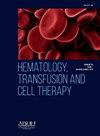99mtc放射性药物包封用磷脂酰丝氨酸脂质体的制备
IF 1.6
Q3 HEMATOLOGY
引用次数: 0
摘要
引言/理由脂质体是一种微小的囊泡,其核心是水,周围有一层脂质双分子层,可以包裹亲脂性和亲水性药物。本研究旨在用磷脂酰丝氨酸制备脂质体,将 99mTc- MDP 包裹在脂质体中,并比较小鼠 4T1 乳腺细胞肿瘤对 99mTc-MDP 和 99mTc-MDP 脂质体的吸收情况。材料与方法在浓度为(9:1)的氯仿/甲醇溶液中加入 90 毫克磷脂酰丝氨酸制备脂质体。在干燥器中蒸发溶剂,直到脂质在小瓶底部形成一层薄膜。放射性药物 99mTc-MDP 是根据放射性标记说明,将冻干试剂盒与 99mTcO4- 溶液复溶而得。用生理盐水重组脂质体,然后加入 99m锝-MDP;将溶液超声 10 分钟。用 Amicon® 10 kD 过滤器进行尺寸排阻过滤,包括两次水洗,以纯化和封装百分比。小鼠 4T1 乳腺癌细胞在补充了 10%胎牛血清的 RPMI-1640 培养基中生长,37°C、5% CO2 的湿润环境中,每孔 5×104 个细胞,在培养条件下过夜。将 99mTc-MDP 和 99mTc-MDP 脂质体加入孔中,一式三份,在培养条件下分别放置 15、30、60 和 120 分钟。移去培养基,用 PBS 冲洗细胞两次,将细胞从孔中分离出来,用伽马计数器测量放射性。结果经尺寸排阻过滤测定,脂质体中 99mTc-MDP 的平均包封率为 68 ± 26%(n = 3)。体外肿瘤细胞对 99mTc-MDP 的吸收率在 0.2% 之间波动。另一方面,99m锝-MDP-脂质体肿瘤细胞摄取率为 0.7% ± 0.1% (15 分钟)、0.8 ± 0.2% (30 分钟)、0.9 ± 0.2% (60 分钟)和 1.2 ± 0.4 (120 分钟)。与单独使用99m锝-MDP相比,负载99m锝-MDP-脂质体的肿瘤摄取率明显较高,这表明磷脂酰丝氨酸脂质体能有效地在肿瘤细胞中递送放射性药物。本文章由计算机程序翻译,如有差异,请以英文原文为准。
PREPARATION OF PHOSPHATIDYLSERINE LIPOSOMES FOR 99MTC RADIOPHARMACEUTICALS ENCAPSULATION
Introduction/Justification
Liposomes are microscopic vesicles containing an aqueous core surrounded by a lipid bilayer, enabling lipophilic and hydrophilic drugs to be encapsulated. Due to this characteristic, they have been used as transporters of substances to treat or diagnose diseases, including radiopharmaceuticals.
Objectives
This work aims to prepare liposome from phosphatidylserine, encapsulate 99mTc- MDP inside it, and compare murine 4T1 breast cell tumor uptake for 99mTc-MDP and 99mTc-MDP-liposome.
Materials and Methods
Liposome was prepared by adding 90 mg of phosphatidylserine in a chloroform/methanol solution at a concentration of (9:1). The solvents were evaporated in a desiccator until the lipids formed a film at the bottom of the vial. The radiopharmaceutical 99mTc-MDP was obtained from the reconstitution of a lyophilized kit with a 99mTcO4- solution, according to radiolabeling instructions. The liposome was reconstituted with saline and 99mTc-MDP was added; the solution was sonicated for 10 min. The purification and encapsulation of percentage were done by size exclusion filtration in an Amicon® 10 kD filter, including two water washes. Murine 4T1 breast cancer cells were grown in RPMI-1640 culture medium supplemented with 10% fetal bovine serum, under 37°C in a humidified atmosphere with 5% CO2 and seed at 5 × 104 cell/well and stood overnight in culture conditions. 99mTc-MDP and 99mTc-MDP-liposome were added to wells, in triplicate, and stood in culture conditions for 15, 30, 60 and 120 min. Culture medium was removed, cells were washed twice with PBS, the cells were detached from the wells, and radioactivity was measured in a gamma counter. The cell internalization percentage was determined by dividing cells counts by a standard sample.
Results
The 99mTc-MDP encapsulation in the liposome reached an average of 68 ± 26% (n = 3), determined by size exclusion filtration. In vitro tumor cells uptake for 99mTc-MDP fluctuated between 0.2% during interval time. On the other hand, 99mTc-MDP-liposome tumor cells uptake had 0.7% ± 0.1% (15 min), 0.8 ± 0.2% (30 min) 0.9 ± 0.2% (60 min) and 1.2 ± 0,4 (120 min).
Conclusion
The experiments demonstrated the feasibility of liposome production and their use for encapsulate 99mTc-MDP radiopharmaceutical. Loaded 99mTc-MDP-liposome had significantly high tumor uptake compared to 99mTc-MDP alone, demonstrating the effectivity of the phosphatidylserine liposome in delivering radiopharmaceuticals in tumor cells.
求助全文
通过发布文献求助,成功后即可免费获取论文全文。
去求助
来源期刊

Hematology, Transfusion and Cell Therapy
Multiple-
CiteScore
2.40
自引率
4.80%
发文量
1419
审稿时长
30 weeks
 求助内容:
求助内容: 应助结果提醒方式:
应助结果提醒方式:


